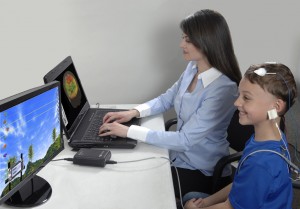 ADHD is the most common neurodevelopmental disorder, affecting between 3-5% of primary school children, and 11% of secondary school children(1).It has a strong genetic component, although it is often hard to tell if it is in the family or not, as less than 25% of adult ADHD sufferers get diagnosed(1).
ADHD is the most common neurodevelopmental disorder, affecting between 3-5% of primary school children, and 11% of secondary school children(1).It has a strong genetic component, although it is often hard to tell if it is in the family or not, as less than 25% of adult ADHD sufferers get diagnosed(1).
For a long time, ADHD treatment was limited to medication. ADHD medications have a great number of adverse side effects, which may include:delayed growth, weight issues, sleep problems, loss of appetite and sometimes even heart problems(2).
This has changed with the development of neurofeedback therapy. Neurofeedback therapy aims to strengthen those areas of the brain that are underactive, by challenging the patient to perform certain tasks(3).Neurofeedback therapy is natural, safe, relaxing and suitable for almost all ages(1). It is said to have great, long-term results that often outlast those of medication(2). For a lot of patients, neurofeedback therapy meant that they were able to reduce their medication usage by up to 50%(2).
ADHD patients are often subdivided into inattentive or hyperactive types, or a combination of both. Common symptoms include:
- Difficulty concentrating
- Restlessness
- Forgetting things
- An inability to relax
- Making simple mistakes
- Feeling nervous or on edge
- Difficulty sleeping
- Moving and talking excessively; and
- Difficulty organizing and completing tasks(1).
This type of behavior can have far-reaching effects at school, work and in the home. Children with ADHD are more likely to drop out of school, smoke cigarettes, have problems maintaining a job, and are more likely to suffer from depression, eating disorders, drug or alcohol abuse, low self-esteem and relationship problems(4). For a lot of sufferers, getting diagnosed with ADHD often comes with a sense of relief, as theycan begin to understand that there are reasonsforthe way that they are, that has nothing to do with a personal character flaw(1).
Neurofeedback therapy uses sophisticated brain-computer technology that pinpoints ‘weak’ areas of the brain and retrains them. QEEG brain scans connect the brain to a computer, which shows a colour-coded map of brain activity levels(4). The patient is then asked to perform a number of tasks, and areas of the brain light up. In ADHD patients, there is often too much slow brain wave activity in the pre-frontal cortex, which is the part of the brain associated with cognition, personality, decision-making and social awareness(1). Once the weakened areas have been found, the patient performs various tasks that concentrate on strengthening the underactive areas of the brain(3). Visual and audio feedback is used so that the patient can understand which areas of the brain need training(3). If the patient loses their concentration, the therapy is instantly stopped until the patient re-focuses. This ensures that the patient remains engaged the entire time, and learns how to stay concentrated(2).
Therapy can help with:
- Concentration
- Restlessness
- Memory
- Organisation
- Self-control
- Depression
- Anxiety
- Learning difficulties
- Social skills
- Motivation
- Sleep problems
- Chronic pain; and
- Resilience(3)
As well as neurofeedback therapy, we can also provide diet, exercise, sleep and time-management advice(1). We would be happy working alongside your GP and psychologist in order to maximize your results.
Reference List:
- Centre PB. ADHD, attention and learning difficulties. 2016 [03/04/2016]. Available from: http://www.perthbraincentre.com.au/attention-learning-difficulties.
- Holland K. Can neurofeedback help treat ADHD? 2014 [03/04/2016]. Available from: http://www.healthline.com/health/adhd/neurofeedback – Overview1.
- Gazal CK. Effective treatment for ADD/ADHD related conditions 2016 [03/04/2016]. Available from: http://www.theaddadhdtreatmentcentre.com.au/.
- Michaels P. Alternative ADHD treatment: neurofeedback 2016 [03/04/2016]. Available from: http://www.additudemag.com/adhd/article/3330.html.